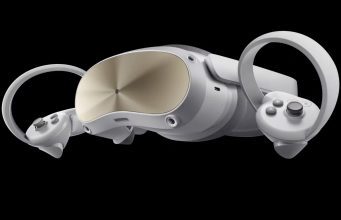
In addition to the consumer-focused Pico 4 headset launched this week, the company is also getting ready to release a business-focused variant called Pico 4 Enterprise, which brings to the platform eye and face-tracking for a price that aims to compete.
Update (October 20th, 2022): Confusingly, it was previously reported that the Pico 4 Pro would be the naming scheme for the company’s business variant, which includes face and eye-tracking, however the company says it will be marketing the headset as Pico 4 Enterprise in the following regions: EMEA, India, Australia and New Zealand. Confusingly, Pico 4 Pro is the naming scheme used in China, where it will be marketed as a consumer-focused device, and offered with 512GB storage. Both Pico 4 and Pico 4 Enterprise feature 256GB.
In addition to announcing the launch of Pico 4 Enterprise coming in December, the company revealed more information, stating that the standalone headset will be priced at €900 or the equivalent in those regions mentioned above, and will include enterprise software management tools. Pico says it’s making it available to registered businesses, and not consumers.
That puts Pico 4 Enterprise at €500 less than its leading competitor, HTC Vive Focus 3, and that’s even before adding officially supported aftermarket face and eye-tracking modules to Vive Focus 3, which would bring Vive Focus 3 to €1,760 in order to match Pico 4 Enterprise’s €900 price tag; that’s around the same as Meta’s Quest Pro mixed reality headset.
To avoid confusion, we’ve updated the piece below to reflect the Enterprise naming scheme.
Original Article (September 23rd, 2022): With the announcement of Pico 4 this week, Pico is squaring up to compete with Meta’s Quest 2. But the company is seemingly also trying to ready itself against Meta’s upcoming Project Cambria, a high-end enterprise-focused standalone headset (which is rumored to be called the Quest Pro).
Alongside the announcement of Pico 4, the company announced Pico 4 Enterprise. Apparently due out later this year, the headset appears to be largely the same from a hardware perspective but with the addition of three internal cameras for eye and face-tracking.
With eye-tracking, Pico says the Pico 4 Enterprise will support automatic IPD adjustment by measuring the user’s IPD each time the headset is put on and then adjusting the IPD distance with a motorized drive. While the Pico 4 also includes a motorized drive, it lacks eye-tracking so the IPD value must be set manually.
Pico also claims the internal cameras can be used for “52 points” of face-tracking, though it isn’t clear if most of those are directly sampled or inferred from a model. Face-tracking is difficult to get right (because the results are highly subject to the uncanney valley and getting a clear view of the face is difficult); the only commercial headsets that have attempted face-tracking have had to employ bulky under-slung cameras. It will be interested to see what Pico can achieve from a largely hidden camera (which is presumably aimed down toward the user’s mouth).
Aside from eye and face-tracking, it appears the Pico 4 Enterprise will be essentially the same hardware otherwise, including a Snapdragon XR2 processor, 2,160 × 2,160 (4.7MP) per-eye resolution, and pancake lenses with a claimed 105° field-of-view. You can see a detailed list of specs for the headsets here.
Note: It was revealed that Pico 4 Enterprise also includes 8GB of LPDDR5 RAM, an upgrade over Pico 4’s 8 GB LPDDR4 RAM.
On the software side, however, Pico 4 Pro will be substantially different. The company says the headset will include an enterprise focused variant of its operating system and won’t require any kind of “personal identification” to operate, which hopefully means no logins.
Pico has yet to announce a specific release date for the Pico 4 Pro, nor a price, though it says the headset will come later this year and will become available in the US at some point.
Additional reporting by Scott Hayden.
from Road to VR https://ift.tt/JuLPEzF
via IFTTT
No comments:
Post a Comment